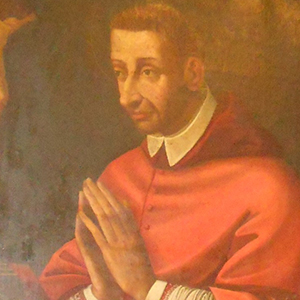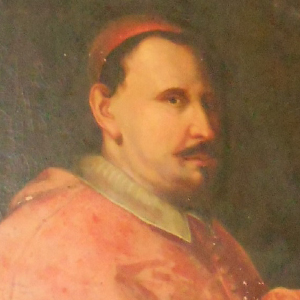This room takes its name from the work ‘Sacrifice to the Pagan Gods’ by Perino del Vaga, which can be found here. A number of divinities can be made out, among whom there is Minerva and Amphitrite, Juno and Venus, Jupiter and Apollo. In the four corners there are painted allegories of the Four Seasons. The religious theme that runs through the furnishings of the room is expressed in a classic style, in line with the general style of the building, and is most likely due to the piety of Andrea Doria, defender of the faith against Turkey.
In the room of sacrifices there are three important tapestries which form part of a series dedicated to the months of the year and the changing of the seasons. In the centre of the room there are a further two portraits: San Carlo Borromeo

, (by artist unknown) who was a relative and frequent correspondent of Andrea Doria I, and the Cardinal Gerolamo Gastaldi,

perhaps painted by Giovanni Maria Morandi with help.
This collection, made from a roll of fabric in Brussels around 1525, was made up of twelve tapestries and was included in the inventory of possessions left by Andrea Doria after his death in 1561. After many changes due to marital splits and destruction, only three parts remain in the Doria collection. These are: January, February and August. These all show a central circular element in which the divinities that mythology associates with the months are depicted. Around them, typical activities of the varying periods of year are shown, in particular relating to agriculture. External to the circle, the winds are shown along with some minor divinities and other scenes related to what would typically happen in that particular month.
In the tapestry of January, the zodiac sign of Aquarius is found. Janus, the divinity that the month’s name is derived from, is the main character in the principal scene, shown in the large central disc. The god, seated at a table, is elegantly dressed in accordance with the renaissance style, and in his left-hand holds two keys to the temple dedicated to him. To the left, in front of the table, is Bacchus, while to the right there is Ceres, whose hair is wrapped in a crown of spikes. In the upper corners, Juno can be seen on his peacock-drawn chariot, along with Iris, winged-messenger of the gods.
The symbol for Pisces is in the circular band seen in the tapestry dedicated to February. In the central circle, the divinity Februus appears. She is the female figure holding a golden sceptre, and symbolizes the purification ceremonies that were characteristic of this month in ancient Rome. All around there are scenes of daily-life, for example, women spinning wool, a child blowing on embers, a man warming himself in front of a fire, and a knight pushing a sleigh on which an elegant lady is seated.
The third panel is dedicated to August. In the middle of the circular band is the zodiac sign for Virgo, that appears in the form of a queen dressed in red. In the upper part of the central circle, Ceres, god of harvest and wealth, overlooks scenes of country life. On the left, a man in bare-feet strikes wheat, while near him two women with their children symbolize fertility. To the right, a young boy is holding a basket full of grapes. Outside the disc, to the top-left, Segesta, the latin divinity of fields who is prayed to during harvest time, can be seen.